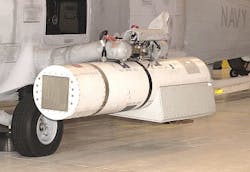Navy's laser-based Airborne Laser Mine Detection System enters final development before full-scale production
PANAMA CITY, Fla., 8 April 2012. U.S. Navy undersea warfare experts are working together with designers at the Northrop Grumman Corp. Aerospace Systems segment in Melbourne, Fla., to move an important laser-based mine-detection system to its final developmental phase before full-scale production.
The Navy awarded Northrop Grumman Aerospace a $27.1 million contract modification Thursday to begin low-rate initial production (LRIP) of the Northrop Grumman AN/AES-1 Airborne Laser Mine Detection System (ALMDS). Awarding the contract were officials of the Naval Surface Warfare Center Panama City Division in Panama City, Fla.
The AN/AES-1 ALMDS electro-optical system, which will be among the first airborne organic mine countermeasure (OMCM) systems fielded, is designed to detect, classify, and pinpoint floating and near-surface moored mines using a light detection and ranging (LIDAR) imaging sensor attached to the side of a Navy MH-60S helicopter.
The system, which will be part of the mine countermeasures (MCM) mission package on the new Littoral Combat Ship (LCS), is designed for rapid wide-area reconnaissance and assessment of anti-ship mines in coastal waters, harbors, confined straits, choke points and amphibious assault areas where aircraft carriers and expeditionary strike groups must operate.
The ALMDS uses pulsed laser light and streak tube receivers housed in an external equipment pod on the MH-60 helicopter. These lasers are designed to search the water column from the surface to about 40 feet in depth -- the area where mines are the biggest threats and coincidentally where mine-hunting sonar systems are least effective. The system takes an image of the entire near-surface water column potentially containing mines.
The ALMDS projects a pulsed wide 538-nanometer blue-green laser beam into the water and samples at rates greater than 100 per second. This wavelength of blue-green laser “can penetrate water much better than other wavelengths. It goes a long way down,” says John Horton, head of the mine warfare systems department at the U.S. Naval Surface Warfare Center in Panama City, Fla.
ALMDS is capable of day or night operations without stopping to stream out or recover equipment and without towing any equipment in the water. It uses the forward motion of the aircraft to generate image data negating the requirement for complex scanning mechanisms.
The system is contained in a pod mechanically attached to the MH-60S with a standard Bomb Rack Unit 14 (BRU-14) mount and electrically via a primary and auxiliary umbilical cable to the operator console. Data is stored on a mass memory unit, and the ALMDS operator's console is common to all MH-60S AMCM systems.
Low rate initial production (LRIP) represents the first small-quantity production of a weapons system for field testing to determine if the system actually performs to requirements. It is the last phase of development before full production.
On the current contract, Northrop Grumman will do the work in Melbourne, Fla.; Tucson, Ariz.; St. Charles, Mo.; Irvine, Calif.; San Clarita, Calif.; and Edgewood, N.Y., and should be finished by April 2014. Contract funds will not expire at the end of the current fiscal year.
For more information contact Northrop Grumman Aerospace online at www.as.northropgrumman.com, or Naval Surface Warfare Center Panama City Division at www.navsea.navy.mil/nswc/panamacity.

